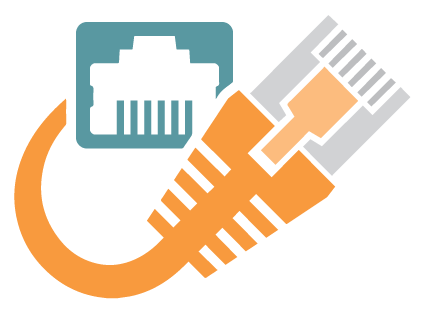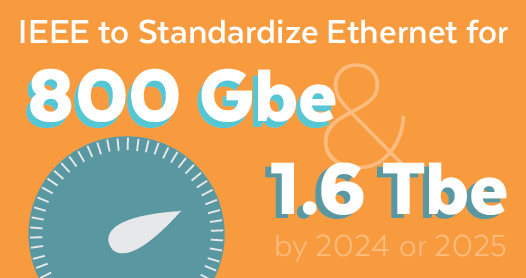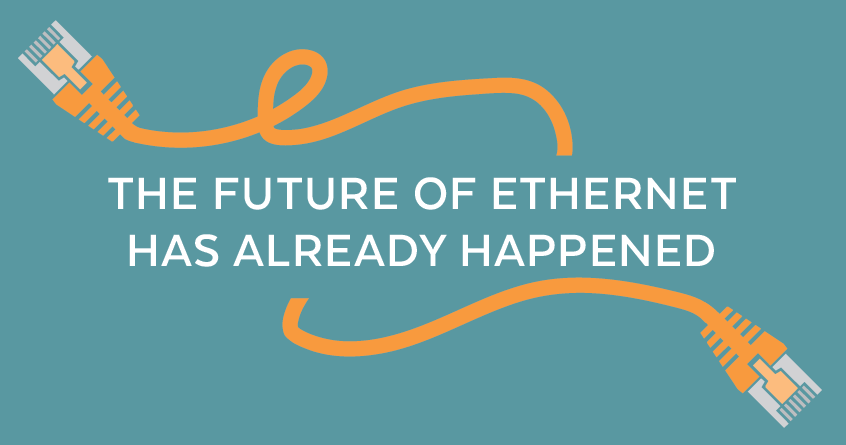Peter Drucker once famously said that trying to predict the future is like driving down a country road at night with no lights while looking out the back window. Essentially, he believed trying to predict the future was an exercise in futility and served no purpose. However, Drucker also thought that we can use our past to guide how we approach our future. Thus, if we want to envision how a technology like Ethernet might evolve, perhaps we should take Drucker’s more helpful advice and look backward. Let’s drive down that country road with the lights on.
What is Ethernet?
Ethernet is a group of networking technologies commonly used in local and wide-area networks. It is a communications protocol that transmits data packets while managing potential data collisions over twisted pairs, coaxial cables, or fiber. Ethernet is the more common name for the Institute of Electrical and Electronics Engineers (IEEE) 802.3 standards, which address ethernet technologies’ physical and transmit layer requirements.
Since its inception in the 1980s (when 10 Mbps was the gold standard), ethernet technology has evolved over the last 50 years by keeping pace with the market’s need for increased bandwidth, more reliable operations, and faster transmission speeds. By 2024, experts expect Ethernet to reach transmission speeds of over 800 GBE. Ethernet has had a time-tested ability to meet the expanding demands of our nation’s infrastructure, solidifying its importance in our society for the foreseeable future.
A Global Crisis
It would be impossible to accurately judge the last five years of human existence without addressing the global impact of the COVID-19 pandemic. Rarely has the world changed so dramatically overnight. How industries responded to the worldwide emergency has already defined the future for many organizations. And indeed, it has set the tone for the future of ethernet.
In a matter of days, businesses of all sizes realized they were not as resilient or agile as they had assumed. Aging infrastructure and an over-reliance on legacy solutions hampered many businesses’ ability to address changing work requirements. We all had to identify what was essential for business survival.
According to the International Monetary Fund, the pandemic forced organizations to expedite their digital transformations. Researchers found that those businesses that had already deployed digital technologies were able to protect employment, mitigate economic disruption, and improve productivity.
Over the last five years, companies have experienced an acceleration in their digital transformation, deploying more digital technologies to improve operational resilience and agility. Businesses turned to ethernet technologies to protect their investments while facilitating digital transformation.
A Changing Workforce
It’s easy to see how the pandemic changed how people worked. It exposed employers and employees to work paradigms beyond the nine-to-five office job. Today, businesses continue to find the right balance of work environments to maintain a productive workforce. Employers are also struggling to fill open positions. This changing dynamic defines ethernet’s future in the workplace.
Local- and wide-area networks expanded when commercial real estate buildings brimmed with employees. Networks needed more bandwidth and faster transmission speeds. Then suddenly, they didn’t. With a massive shift toward remote work, many LAN-connected workstations sat idle.
Although 38% of companies have mandated a return to the office, most now offer their employees a hybrid environment. This move requires changes in policies and procedures that take time to develop and implement. Hybrid work also means network changes, as many companies seek to reduce or reconfigure office space to lower costs and maximize resources.
 Ethernet infrastructures deliver the flexibility that network administrators need. Ethernet can quickly turn conference rooms into shared workspaces with more connections and faster speeds. If businesses want to reduce office space while expanding their network, ethernet technology allows administrators to adjust their infrastructure at minimal cost.
Ethernet infrastructures deliver the flexibility that network administrators need. Ethernet can quickly turn conference rooms into shared workspaces with more connections and faster speeds. If businesses want to reduce office space while expanding their network, ethernet technology allows administrators to adjust their infrastructure at minimal cost.
According to McKinsey, 8.6 million people made an occupational shift between 2019 and 2022, and another 12 million workers are expected to make an occupational shift by 2030. Some shifts will be voluntary, while others will result from automation, increased focus on infrastructure, and occupational restructuring. As technology plays a larger role in shaping the workforce, the demand for faster and more reliable ethernet will continue to grow.
Companies will expect more from their ethernet infrastructure as they use technologies such as artificial intelligence (AI) and machine learning (ML) to address labor shortages. Technology will become an integral component of their employment strategy.
A Faster Future
AI has already impacted ethernet’s future. A recent MIT study found that 80% of Amazon Web Services (AWS) users believe AI will transform their organizations. More companies are considering increasing their investment in AI technology, though only 6% have implemented generative AI in their daily operations. Most organizations are interested in the potential benefits of AI but are hesitant to adopt it until they see its value.
AI applications require more bandwidth and faster transmission speeds. Although opinions vary on ethernet’s ability to deliver in an AI-dominated environment, the Ultra Ethernet Consortium (UEC) formed in 2023 would indicate otherwise. Companies like AMD, Cisco, HPE, Intel, and Microsoft established the UEC to advance ethernet technologies for handling AI performance, bandwidth, and scale. In November, another 27 organizations joined the consortium, indicating a desire to address ethernet’s physical, link, software, and transport layers in AI/ML applications.
The Ethernet Alliance views the UEC as an indication of the resilience of ethernet technologies, and participation by major tech companies signals a desire to leverage existing ethernet infrastructures to meet AI processing demands. The IEEE is working to standardize Ethernet technologies for 800 GBE and 1.6TbE transmission speeds, with target dates of 2024 and 2025, respectively.
Ethernet’s future revolves around its ability to handle the increasing demands of larger workloads. Its history of compatibility with existing architectures allows organizations to protect their initial investments, while ongoing development and deployment will improve reliability, decrease latency, and increase performance.
Country Roads and the Future of Ethernet
When we think of traveling down country roads in daylight, we think of wide-open spaces. We willingly suffer bumps in the road for a tranquil drive through country landscapes. We even delight in the surprises that unexpected turns provide.
Looking through the back window of ethernet’s journey, we see a reliable technology that has evolved to meet many unforeseen demands over the last 50 years. The technology has brought businesses to where they are today—approaching another turn in the road that will require faster transmission speeds and improved reliability.
Looking out the front window on our drive, we see the wide-open spaces that define the future of Ethernet technologies. We may not know what lies around the next bend, but ethernet’s 50-year legacy can perhaps offer some comfort.
Versa Technology has shared ethernet’s journey since 1994 and remains committed to advancing ethernet technologies through its network products and solutions. Contact us for more information on how our products can make your journey more comfortable.
Sources:
Peter Drucker Quotes. (n.d.). BrainyQuote.com. Retrieved February 10, 2024, from BrainyQuote.com
Website: https://www.brainyquote.com/quotes/peter_drucker_129870
Peter Drucker. The Future that Has Already Happened. Retrieved February 10, 2024, from HarvardBusinessReview.org
Website: https://hbr.org/1997/09/looking-ahead-implications-of-the-present

